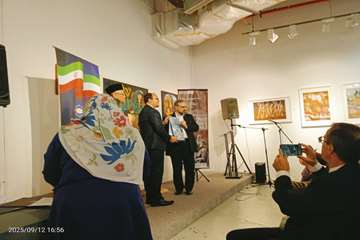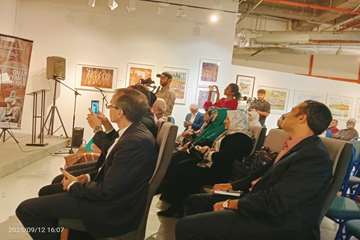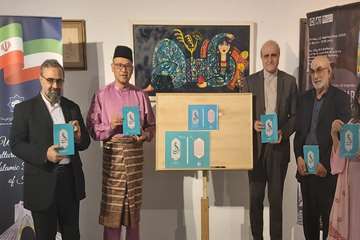Hud Hud Historical Cultural Messenger Between Persian and Malay Civilisations Book Launched at Art Gallery Kuala Lumpur September 12, 2025
_crop.jpg)
When I first visited Malaysia in 1990, no new developments, like KLA or Smart Tunel, had been made registered under the name of Malaysia. You would encounter expressions like “selamt Datang” when you arrived at Sabang Airport (the airport at the time), which caused you to consider the connection between these terms and their Malay, Arabic and Persian parts. Until. In 2006, Higher Education Ministry of Iran to sent as the first scientific adviser to that South Pacific Asia region, and this time at the Kuala Lumpur Airport, you would meet the same phrases with Persian words again. During my mission, I never neglected to decipher their secrets and connections, but the heavy work and leadership of Iranian students, with an average of 10,000 students in 2009, was done only in Malaysia and 200 in other countries of that region. Nine countries—Malaysia, Singapore, Indonesia, the Philippines, Thailand, China, South Korea, and Japan—never left room for other work, and this issue remained at the level of the same thought. I started the main research work on this topic in 2015 and finally completed it in 2024 as a rigid field of research. I found people in Malysia with a Muslim oriental temperament, whose pride is Islam, and we have talked about this culture and its relationship with other cultures.
Both Iranian and Malay cultures, with their rich and complex histories, have been influenced by cultural, commercial, and social interactions over the centuries. Iran, with its ancient history and great civilisations, has always been known as a cultural and scientific centre in the Middle East region and beyond. The Persian language, rich literature, visual arts, and Persian music are all key elements of Iranian culture that have been influential in interactions with other cultures, especially Malay culture.
The Malay Archipelago, with its cultural and linguistic diversity, has served as a meeting point for different cultures. Through maritime trade routes and cultural exchanges, Iranian elements have naturally entered and integrated into Malay culture. These influences are clear not only in language and literature but also in art, architecture, music, and even cooking.
The Malay language, an important language of the region, has been influenced by Persian and has borrowed many words and expressions from it. These borrowings have not only added to the richness of the Malay vocabulary but have also led to semantic and cultural changes. Persian literature, with its great poets and writers, has profoundly affected Malay literature, introducing new genres in this field.
In art, Iranian influences are clear in Malay visual arts. Calligraphy, miniature painting, and textile design have all been influenced by Iranian art. In addition, the architecture of Malay mosques and monuments has gained a special effect by being inspired by Iranian patterns, especially in the design of domes and arches.
Music is another area in which Iranian influences are clear. Instruments such as the Rabat and tabla, which have Iranian roots, are used in Malay music, and Persian melodic patterns and rhythms have permeated folk songs in Malaysia. These influences can be seen in traditional music and in contemporary Malay music.
Malay cuisine has also not been neglected in Iranian works. Iranian flavours and aromas, using special spices and ingredients, have given Malaysian cuisine its unique features. Cooking methods and combinations of spices have added colour and flavour to Malaysian cuisine and enriched the region’s food diversity.
Festivals and customs in Malaysia also show Iranian influence. From wedding traditions to festive ceremonies, Persian dresses and accessories, such as brooches and bracelets, blend harmoniously with local fashion. It deals with this cultural fusion, which represents a dynamic and vibrant cultural exchange.
The study of the profound influence of Persian poetic language on Malay literature relates to historical narratives, literary masterpieces, linguistic analyses, and cultural works. This article discovers the origin, evolution, and manifestations of the cultural fusion of Iranians and to represent the complex cultural mosaics that adorn the Malay Archipelago.
A chapter examines Persian vocabulary in Malay, semantic variations, and linguistic homogenisation, shedding light on the historical and cultural contexts of these borrowings. Another chapter focuses on grammar and examines the influence of Persian on Malay syntactic structures, word order, and grammatical differences in Malay.
Malay literary property ancient traditions, through the study of Persian poets, scholars, and writers whose works have had a lasting impact on Malay literary expression, this Iranian action on Malay visual arts, from calligraphy to miniature painting and textile design, is visible.
This research is an attempt to deepen the cultural relations between Iran and Malaysia and the Malay-speaking countries of this region, which examines familiarity with the rich history and culture of these two lands and the study of their mutual effects. This research not only examines cultural influences but also analyzes how new cultural identities are formed because of these interactions. This is not the end of the matter, and there is room for many other studies to find links between the two Iranian and Malay civilisations.
Dr. Vahid Alli




Write your comment.